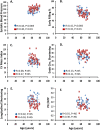Left ventricular functional, structural and energetic effects of normal aging: Comparison with hypertension
- PMID: 28493996
- PMCID: PMC5426746
- DOI: 10.1371/journal.pone.0177404
Left ventricular functional, structural and energetic effects of normal aging: Comparison with hypertension
Abstract
Objectives: Both aging and hypertension are significant risk factors for heart failure in the elderly. The purpose of this study was to determine how aging, with and without hypertension, affects left ventricular function.
Methods: Cross-sectional study of magnetic resonance imaging and 31P spectroscopy-based measurements of left ventricular structure, global function, strains, pulse wave velocity, high energy phosphate metabolism in 48 normal subjects and 40 treated hypertensive patients (though no other cardiovascular disease or diabetes) stratified into 3 age deciles from 50-79 years.
Results: Normal aging was associated with significant increases in systolic blood pressure, vascular stiffness, torsion, and impaired diastolic function (all P<0.05). Age-matched hypertension exacerbated the effects of aging on systolic pressure, and diastolic function. Hypertension alone, and not aging, was associated with increased left ventricular mass index, reduced energetic reserve, reduced longitudinal shortening and increased endocardial circumferential shortening (all P<0.05). Multiple linear regression analysis showed that these unique hypertensive features were significantly related to systolic blood pressure (P<0.05).
Conclusions: 1) Hypertension adds to the age-related changes in systolic blood pressure and diastolic function; 2) hypertension is uniquely associated with changes in several aspects of left ventricular structure, function, systolic strains, and energetics; and 3) these uniquely hypertensive-associated parameters are related to the level of systolic blood pressure and so are potentially modifiable.
Conflict of interest statement
Figures




Similar articles
-
Left ventricular torsion, energetics, and diastolic function in normal human aging.Am J Physiol Heart Circ Physiol. 2012 Feb 15;302(4):H885-92. doi: 10.1152/ajpheart.00985.2011. Epub 2011 Dec 16. Am J Physiol Heart Circ Physiol. 2012. PMID: 22180656 Free PMC article.
-
Relationship between left ventricular diastolic relaxation and systolic function in hypertension: The Hypertension Genetic Epidemiology Network (HyperGEN) Study.Hypertension. 2001 Sep;38(3):424-8. doi: 10.1161/01.hyp.38.3.424. Hypertension. 2001. PMID: 11566916
-
Association of target organ damage with 24-hour systolic and diastolic blood pressure levels and hypertension subtypes in untreated Chinese.Hypertension. 2014 Feb;63(2):222-8. doi: 10.1161/HYPERTENSIONAHA.113.01940. Epub 2013 Nov 18. Hypertension. 2014. PMID: 24246384
-
Clinical measurement of arterial stiffness obtained from noninvasive pressure waveforms.Am J Hypertens. 2005 Jan;18(1 Pt 2):3S-10S. doi: 10.1016/j.amjhyper.2004.10.009. Am J Hypertens. 2005. PMID: 15683725 Review.
-
Heart failure with normal systolic function.Clin Geriatr Med. 2000 Aug;16(3):489-512. doi: 10.1016/s0749-0690(05)70025-2. Clin Geriatr Med. 2000. PMID: 10918644 Review.
Cited by
-
Left ventricular geometry, tissue composition, and residual stress in High Fat Diet Dahl-Salt sensitive rats.Exp Mech. 2021 Jan;61(1):191-201. doi: 10.1007/s11340-020-00664-8. Epub 2020 Sep 14. Exp Mech. 2021. PMID: 33776071 Free PMC article.
-
Cardiac System during the Aging Process.Aging Dis. 2023 Aug 1;14(4):1105-1122. doi: 10.14336/AD.2023.0115. Aging Dis. 2023. PMID: 37163425 Free PMC article. Review.
-
Left Ventricular Diastolic Function Studied with Magnetic Resonance Imaging: A Systematic Review of Techniques and Relation to Established Measures of Diastolic Function.Diagnostics (Basel). 2021 Jul 16;11(7):1282. doi: 10.3390/diagnostics11071282. Diagnostics (Basel). 2021. PMID: 34359363 Free PMC article. Review.
-
A meta-analysis of the haemodynamics of primary hypertension in children and adults.J Hypertens. 2023 Feb 1;41(2):212-219. doi: 10.1097/HJH.0000000000003326. Epub 2022 Dec 2. J Hypertens. 2023. PMID: 36583348 Free PMC article.
-
Blood Lead Mediates the Relationship between Biological Aging and Hypertension: Based on the NHANES Database.Nutrients. 2024 Jul 5;16(13):2144. doi: 10.3390/nu16132144. Nutrients. 2024. PMID: 38999891 Free PMC article.
References
-
- Avolio AP, Chen SG, Wang RP, Zhang CL, Li MF, O'Rourke MF. Effects of aging on changing arterial compliance and left ventricular load in a northern Chinese urban community. Circulation 1983; 68: 50–58. - PubMed
-
- Hollingsworth KG, Blamire AM, Keavney BD, MacGowan GA. Left ventricular torsion, energetics, and diastolic function in normal human aging. American Journal of Physiology-Heart and Circulatory Physiology 2012; 302: H885–H892. doi: 10.1152/ajpheart.00985.2011 - DOI - PMC - PubMed
-
- Cheng S, Fernandes VR, Bluemke DA, McClelland RL, Kronmal RA, Lima JA. Age-related left ventricular remodeling and associated risk for cardiovascular outcomes the multi-ethnic study of atherosclerosis. Circulation: Cardiovascular Imaging 2009; 2: 191–198. doi: 10.1161/CIRCIMAGING.108.819938 - DOI - PMC - PubMed
-
- National Heart Failure Audit. https://www.ucl.ac.uk/nicor/audits/heartfailure/documents/annualreports/.... Accessed 19/4/2016
-
- Chantler PD, Lakatta EG. Arterial-ventricular coupling with aging and disease. Front Physiol. 2012; 3: 90 doi: 10.3389/fphys.2012.00090 - DOI - PMC - PubMed
MeSH terms
Grants and funding
LinkOut - more resources
Full Text Sources
Other Literature Sources
Medical

